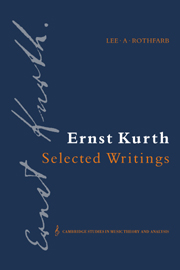Book contents
- Frontmatter
- Contents
- Foreword by Ian Bent
- Preface
- Notes on the translation
- Introduction
- Part I Grundlagen des linearen Kontrapunkts (Foundations of linear counterpoint)
- 1 Polyphonic structure
- 2 Thematic and motivic processes
- 3 Polyphonic melody
- Part II Romantische Harmonik und ihre Krise in Wagners “Tristan” (Romantic harmony and its crisis in Wagner's “Tristan”)
- Part III Bruckner
- Appendix: Complete tables of contents for Kurth's Grundlagen des linearen Kontrapunkts, Romantische Harmonik und ihre Krise in Wagners “Tristan” and Bruckner
- Select bibliography
- Index of musical examples
- General index
2 - Thematic and motivic processes
Published online by Cambridge University Press: 10 December 2009
- Frontmatter
- Contents
- Foreword by Ian Bent
- Preface
- Notes on the translation
- Introduction
- Part I Grundlagen des linearen Kontrapunkts (Foundations of linear counterpoint)
- 1 Polyphonic structure
- 2 Thematic and motivic processes
- 3 Polyphonic melody
- Part II Romantische Harmonik und ihre Krise in Wagners “Tristan” (Romantic harmony and its crisis in Wagner's “Tristan”)
- Part III Bruckner
- Appendix: Complete tables of contents for Kurth's Grundlagen des linearen Kontrapunkts, Romantische Harmonik und ihre Krise in Wagners “Tristan” and Bruckner
- Select bibliography
- Index of musical examples
- General index
Summary
Our chapter 2 is a translation of most of part 4, chapter 4 of Grundlagen, 3rd edn., entitled “Polyphonic Structure.” As mentioned in the introduction to our chapter 1, part 4 of Grundlagen discusses general characteristics of polyphonic structure (part 5 investigates specific techniques of joining two and more melodic lines). Part 4 examines complementary rhythm, special treatment of apex pitches (see our chapter 1), techniques of melodic and textural intensification, and the relationship between linear contour and harmonic dissonance. In chapter 4 Kurth explores “Consolidation and Dissolution of Thematic Motion,” and proposes the idea of developmental motives (Entwicklungsmotive), melodic kernels that are “a kind of distillation of melody down to pure symbols of motion” (p. 436).
By thematic consolidation and dissolution (Verdichtung, Auflösung) Kurth means the process which a theme (for example a fugue subject) undergoes over the course of a polyphonic piece. Once stated, the theme dissolves into generic motivic shapes (developmental motives) during transitional passages (Zwischenspiele), and then crystallizes during thematic presentations (Durchführungen). Kurth's mode of thematic analysis implies a dynamic understanding of form based on the aforementioned general traits of polyphonic structure in the context of an alternation between thematic crystallization and dissolution.
- Type
- Chapter
- Information
- Ernst Kurth: Selected Writings , pp. 58 - 74Publisher: Cambridge University PressPrint publication year: 1991



